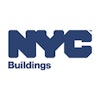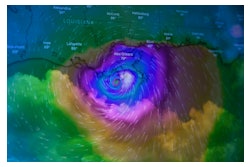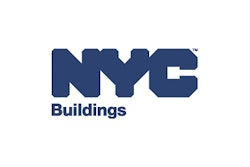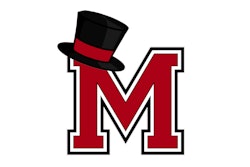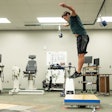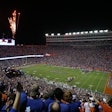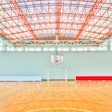While the idea of building an outdoor competition track in any length other than 400 meters is preposterous, no one bats an eye at the variation in indoor track lengths.
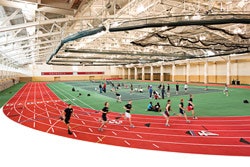 (Photo of Grinnell College's Charles Benson Bear '39 Recreation and Athletic Center © Robert Benson Photography, courtesy of SasaKi Associates Inc.)
(Photo of Grinnell College's Charles Benson Bear '39 Recreation and Athletic Center © Robert Benson Photography, courtesy of SasaKi Associates Inc.)While the idea of building an outdoor competition track in any length other than 400 meters is preposterous, no one bats an eye at the variation in indoor track lengths. From the 160-yard track (about 146 meters) at Madison Square Garden all the way up to the 442-meter Utah Olympic Oval, the only thing consistent about indoor track lengths is their inconsistency.
A standard does exist, though - kind of. Both the IAAF and NCAA define a standard indoor track as 200 meters, but the NCAA indoor track and field rules book, in recognizing that holding all institutions to that standard isn't feasible, tempers that specification with, "This distance may be reduced or exceeded."
"Would the track and field community in the United States like to have a standard?" asks NCAA track and field secretary rules editor Bob Podkaminer. "I think the answer is yes. But we were never able to get there from the beginning.
"You have to go back and look at what a standard indoor-sized facility was in the 1940s or '50s," he explains. "They shoehorned tracks into existing buildings. They were 160 yards, not 220 yards. The buildings they were putting these things into couldn't accommodate what they considered at that point to be huge tracks."
That flexibility has been and continues to be good for athletic departments trying to maximize the use of space, but the track and field community has known for years that nonstandard tracks result in variations in performance, giving athletes running on one type of track an advantage over others. "A banked 200-meter track is different than a 300-meter oversized track," says Pat Henry, head coach of the Texas A&M indoor and outdoor men's and women's track programs. "There's no question about it. And one one-thousandth of a second makes the difference in whether you advance to the national meet or not."
Until now, no one was able to do anything about the differences in track performance. "Everybody had a perception of what was going on, but nobody had any data," says Podkaminer. Beginning in 2007, however, automated timing systems became prevalent enough to gather accurate data, and in 2010, the NCAA began mandating full-season data collection from all three divisions.
Podkaminer and a subcommittee comprised of three other NCAA representatives have scrutinized that data, putting together a recommendation for an indexing system to equate times earned on nonstandard tracks to a standard that the NCAA will be using for the 2012-13 season. The index breaks tracks down into two non-standard types - undersized and oversized/banked tracks. "Feedback is both positive and negative, as you might expect," says Podkaminer. "I don't think there is anyone who says it was not needed."
Today, indoor track and field facilities continue to perform double duty, providing practice space for field sports or accommodating tennis or basketball courts inside the oval. Building a standard-sized track just isn't practical. "To accommodate the track oval plus a one-meter safety zone on the outside of the track, the building you would build for a 200-meter, eight-lap track with four lanes around the oval would need to be 160 by 300 feet," which is not an insignificant amount of space, explains Doug Hill, a consultant with Mondo USA.
"A lot of schools have other demands for large spaces," says Chris Sgarzi, a principal with Sasaki Associates of Watertown, Mass. Especially in the Northeast, Sgarzi says, the demand for indoor field space is driving construction of larger tracks. "We're seeing more that put turf on the infield so they can practice soccer or lacrosse or accommodate other outdoor sports programs that need to be practicing inside when it's muddy. The driver in that case is the field, and then you get the track as sort of an afterthought, versus the track being the priority and the infield as an afterthought."
Cost constraints can result in a larger or smaller track, depending on the facility's primary use. While a 300-meter track is more expensive than a 200-meter track, for schools that are trying to get the most out of one space, a larger track with a turf infield for field sports would be more cost-effective than building two separate facilities. "It's based on the economics of what the university can afford," says Hill. "What you do is try to make a facility truly multipurpose. If I'm going to build an indoor football practice facility, I go with a 300-meter track."
Keeping the size of the track constant but adding additional functions to the infield increases the size and cost of the project, as well. "One of the big factors that you run into is where you're going to do the field events," says Sgarzi. "Turf in the infield pushes the field events outside of the oval, which makes the building larger."
Another consideration is whether the track is going to be used just for practice or whether it will host meets, which would require additional space for spectators. "The other thing about track events is that you end up with multiple teams, a lot of athletes waiting for their events or wanting to warm up," adds Sgarzi. "The better facilities will have warm-up lanes and space for athletes to prepare for events. It goes back to what your priorities are for that facility."
The NCAA's indexing system essentially endorses the continued deviation in track length, although Sgarzi thinks it will have little effect on the future of track construction. The 200-meter track is still the internationally recognized ideal, and cost and site constraints will still be the determining factors. "I don't see it as a big change in what people will construct," he says. "But it's helpful for people who have already created buildings that don't conform with the 200-meter standard."
Texas A&M's Henry agrees that the index does make the sport more fair, but he's not sure that it's what the sport needs. "You have to draw some lines," he says, comparing track and field facilities to the range in caliber of football programs. "Athletics isn't fair everywhere. That's why there's a BCS. There are only so many football teams that have the opportunity to win the national championship, and you're not going to have a team come out of a smaller school and win."
His concern is less about creating fairness for individual athletes and more about strengthening the sport as a whole. "The difference between tracks is something they're trying to address," he says, "but this index may change again next year, and the year after that. We continue to convolute the sport and make it harder for the general public to understand what in the world we are doing. How am I going to get fans to walk in the door, sit down and understand what is going on?"
Building a sport around the needs of fans instead of athletes isn't as counterintuitive as the idea may initially seem. "The BCS schools have built stadiums that seat 80,000 people," says Henry. "Not every school builds a stadium that seats 80,000."
That's because not every school can draw 80,000 fans. If a sport can gather the interest - and dollars - of a significant fan base, the facilities built reflect it. Texas A&M's Division I indoor track program has a dedicated facility featuring a 200-meter banked track - and seating for 5,000 spectators. "It goes back to what your priorities are for that facility," says Sgarzi. Building a nationally recognized track program and the fan base that goes with it starts with attracting the best athletes in the country, which is nearly impossible without a banked 200-meter track. But, adds Sgarzi, "Once you put the banking in, it makes your facility less flexible." Even a hydraulic track that can be raised for competition and lowered for other uses requires extra space in the floor to house its mechanics, and represents a significant cost investment.
Schools like Texas understand that the investment is worth it. "It does give us an advantage," Henry says. "And our school spent $30 million to create that advantage."
Not only does a dedicated track facility offer competitive and recruiting advantages, it can be a draw for both international and local competitions. "This year, the NCAA finals will be at Arkansas on a Mondo 200-meter banked portable track," says Hill. "If I'm a coach, I want to take my athletes somewhere that has a banked track like they have in Arkansas."
 EXTRA LIFT A banked portable track, like the one used for the NCAA Division I National Championships at the University of Arkansas, offers one solution for facilities trying to get the most use out of space. (Photo Courtesy of Mondo USA)
EXTRA LIFT A banked portable track, like the one used for the NCAA Division I National Championships at the University of Arkansas, offers one solution for facilities trying to get the most use out of space. (Photo Courtesy of Mondo USA)"We stay on a banked 200-meter track because that's the track the national championship is held on," confirms Henry. But, he admits, a banked track doesn't guarantee a successful program. Prior to the national championship, there is the traditional "last chance" meet - the last opportunity for an athlete to qualify for the national competition. This often places runners on a style of track unfamiliar to them. But it's necessary, says Henry. "The last meet of the year, we have to go to wherever the great competition is. If you don't go to that meet, you don't get in."
That last-chance meet highlights what Henry thinks is one of the more important factors in race outcomes. "It's not just the track, it's the competition on the track," he says. "Everybody goes to one track the last weekend of the season, and it creates such a competitive environment."
The "competitive environment" is one of a long list of other factors that contribute to overall track performance, something the NCAA committee recognized in its study. "This is the beginning, not the end," says Podkaminer. "When our report was done, one of the recommendations was don't stop, you've got to grab the data, compare it to our findings and see whether there's variation in any other way, what that variation is, and make adjustments as appropriate."
But to take all the factors, such as the lane the runner was in, the number of lanes, the lane width or track radius would result in data subsets so small that any findings could be insignificant. "The typical radius on a 200-meter track is usually 60 to 62 feet," says Hill. "The University of Florida has an 83-foot radius on its indoor track. The track in Madison Square Garden, which is 11 laps to the mile, has a 37.26-foot radius."
The index also doesn't account for variations within events. For shorter events, like the 200 and 400 meters, Podkaminer notes, runners stay in the same lane throughout, unlike longer events like the 5,000 meters. But again, taking such factors into consideration at this time just isn't feasible. "From the 2012 season, for the 200-meter men's indoor only, there were more than 15,000 points of data," Podkaminer says. "It wasn't small. I can't say that for the 5,000 meters, because people don't run it as often. It is an enormous chore to simply process the data for any one year."
It's not a perfect system, but it's a start. "I think it's the fairest system that they've got," says Hill. "It's not 100 percent accurate, but maybe 97 percent. It has only been three years of gathering data and indexing. All it's going to do is improve."
The potential is out there, Podkaminer thinks, to break down the data to consider all of the factors that the initial study excluded. The future he sees is similar to the course rating system used in golf, where each course has a unique rating to gauge its level of difficulty in comparison to other courses. "What you're really asking for now, because of these minute differences that occur, is the creation of an index for every single track, every facility," he says. "There's no reason why you couldn't hold that up as the shining light that you're striving for."













